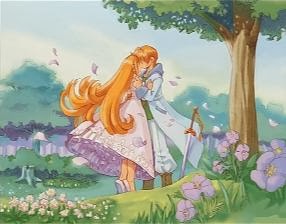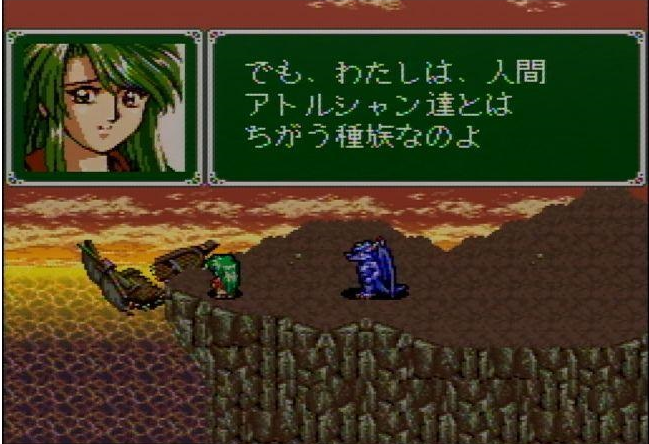Name: Regaia Densetsu (レガイア伝説)
Type: Fantasy RPG
Available Languages: Japanese, English
I thought that today I’d talk about a game that has one of my all-time favorite story premises, Regaia Densetsu (Regaia Legend). I first ran across this game many years ago under its western release name, Legend of Legaia, and have not found many stories that start off with such a feeling of despair. What small knots of humanity are left safe in the world, and you have no idea how many of them there are, are trapped in small clusters, waiting for what seems to be their inevitable demise.
The world is covered by a malevolent mist, the origins of which are shrouded in mystery. The mist is in and of itself harmless, but it causes Seru, creatures that have thrived symbiotically with humans for many years, to become mad. When surrounded by the mist, Seru will kill humans, and humans already wearing a Seru will become crazed monsters. So needless to say, whatever humans could escape this terrifying epidemic, did, be it by building high walls, climbing buildings tall enough that the mist could not reach them, or by creating complex air supply systems to blow the mist out while cycling fresh air in.
The main protagonist, Van, lives in a town surrounded on one side by water and on the other by high walls, the only thing that keeps the mist and the menacing Seru that it contains from spilling into the town and killing or enslaving the bodies of all who dwell there. His goal in life is to become a hunter, one of the men of the village who brave the dangers outside the wall in order to bring back food for the village of Rimu Erumu. The game makes sure that you feel the sense of immediate danger right from the beginning, as Rimu Erumu, for all its quaint charm, is a town just waiting for the other shoe to drop. People die to bring back food for the villagers to survive, and are going to keep dying for as long as the mist lasts.
This turns out not to be a problem for as long as
you would think, as pretty soon after the game begins, Seru force their way
into Van’s peaceful hometown and start wreaking havoc. It’s at this point that
Van meets his traveling companion, the Ra Seru Me-ta, who has the ability to
help him clear the mist and hopefully find the source of the world’s problems.
Van and Me-ta help the World Creation Tree grow in the middle of town, and it
clears the mist from Rimu Erumu and the surrounding area, leaving you free to
go on your journey of discovery while your family and friends rebuild what was
destroyed by the invasion of the Seru.
There are two other playable characters available in
this game as well, a girl who was raised by a wolf, and a monk who follows a
discipline that shuns the use of Seru. Each of them have their own strengths
and characteristics and make for interesting travelling companions. You’re
certain to get different viewpoints from a boy who was locked in a village for
his entire life, a girl who was raised by a Ra Seru possessed wolf, and a monk,
after all.
The Tactical Arts System, the battle system for
Regaia Densetsu, is really interesting. Each character can learn new techniques
by putting in combinations of button commands and seeing if the character
learns new Arts or Hyper Arts from it. Not only are these powerful tools in
your arsenal, but they look rather cool too, making the RPG battles appear
almost reminiscent of a fighting game.
The magic system is a little less fun for me, given
that it can be quite a pain at times. As your characters possess Ra Seru, they
can learn how to summon a defeated Seru. The problem with this is that you have
to knock said Seru down to just the tiniest bit of health without killing it,
and then only the character who landed the last blow learns the summon. This
doesn’t even work one hundred percent of the time, so if you’re trying to teach
all three of your characters all of the Seru summons there are to learn, you’ll
have quite a long road ahead of you.
The game falls short a bit in the looks department,
as out of battle I’ve always felt that the blocky sprites look like they come
from a poor man’s Final Fantasy VII. In battle, they look quite a bit better,
though, as they need to be more fluid in order to perform the special attacks
properly.
The story, as I’ve already said, is very much to my
taste, with the creeping mist covering the planet and only you and your Ra Seru
companions standing between it and complete takeover. Your goal is to revive
all of the World Creation Trees and drive out the mist, hopefully finding the
source and taking it out too. Of course there are those out there who are very
much against you succeeding in your plans, in some cases those who created the
mist in the first place and in others people who are fighting for more personal
reasons. When you do finally find out the truth behind the mist, and one of
your party member’s unknowing connection to it, it is every bit as horrible and
strange as you would expect. I will not spoil it here, suffice it to say that
it is worth the price of admission.
If you couldn’t tell by what I have written so far
about this game, I am a really big fan of it. The story had me from the
beginning, it being the type that grabbed me and would not let go. I truly
wanted to know the source of the mist, and who would create such a terrible
thing to wreak havoc on innocent people. You feel quite a bit like a cornered
animal at the beginning of Regaia Densetsu, with no escape and no way to fight
back. The Ra Seru and your own will are the only tools you have to stand
between you and something so unpleasant that by the time you’re done, you’ll
feel that you’ve earned your happy ending. At the end of the game, Van gets to
choose between one of several endings, and while there is only one that I
personally consider to be cannon, the choice is yours. Frankly, I would have
preferred one ending that was longer instead of a shorter
choose-your-own-ending, but that’s a personal pet peeve. Either way, this game
is a great way to spend a few days, and if you haven’t gotten around to playing
it yet, what are you still reading this for? Do yourself a favor and track down
a copy as soon as possible.
If you feel like hearing more of my
gaming prattle, feel free to follow me on Twitter. You can find me at @bejiita_buruma


















